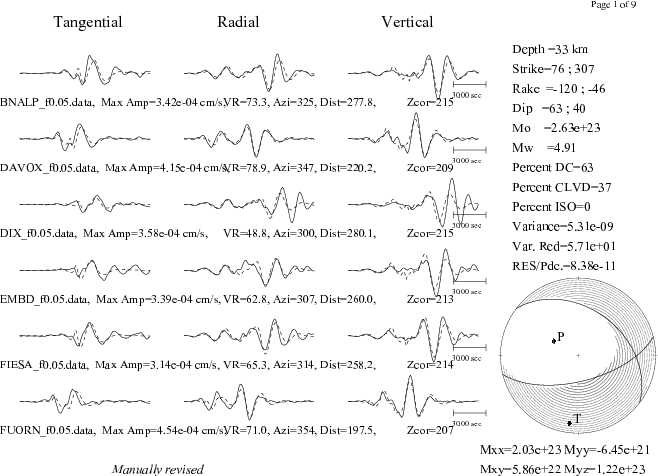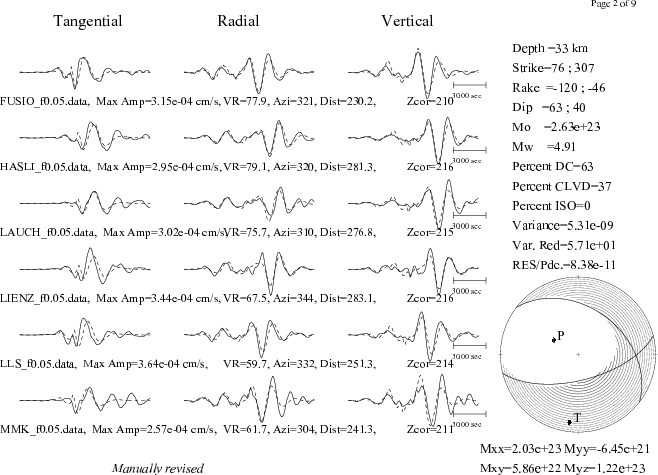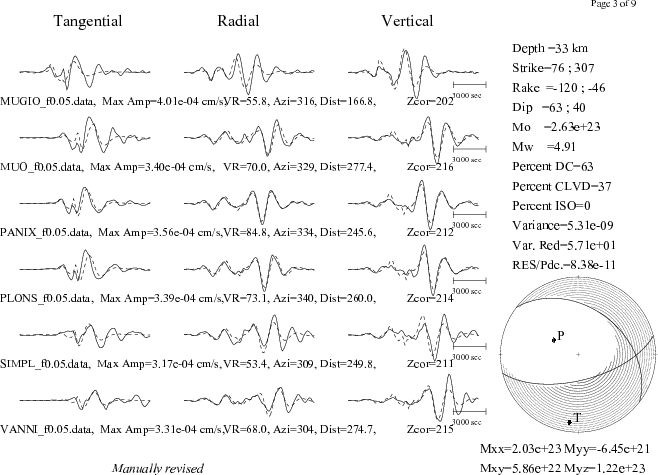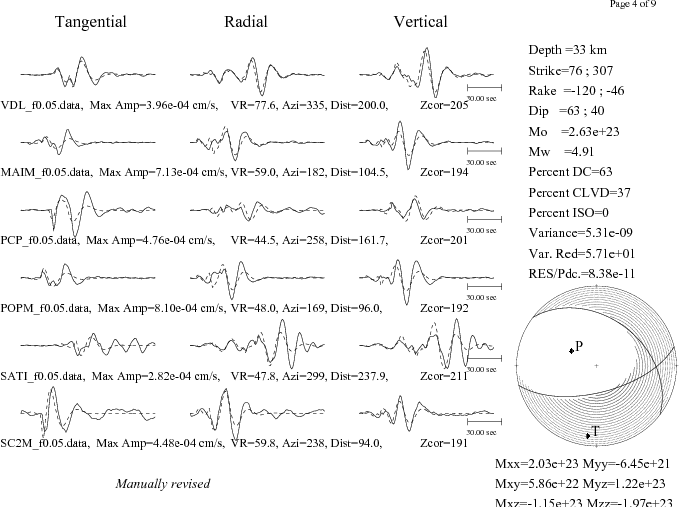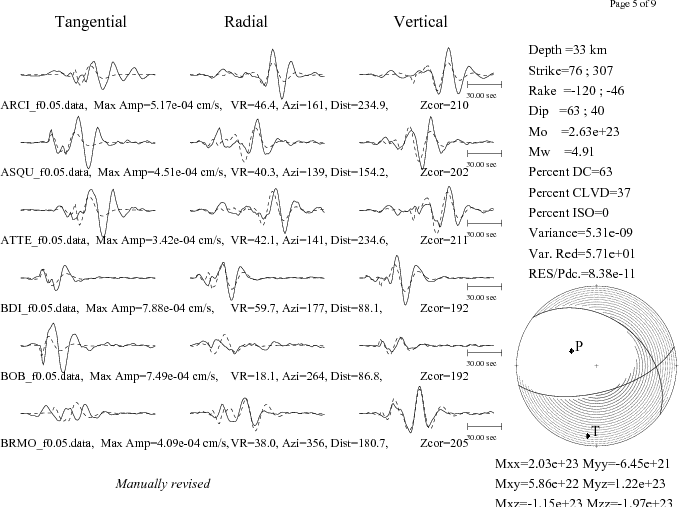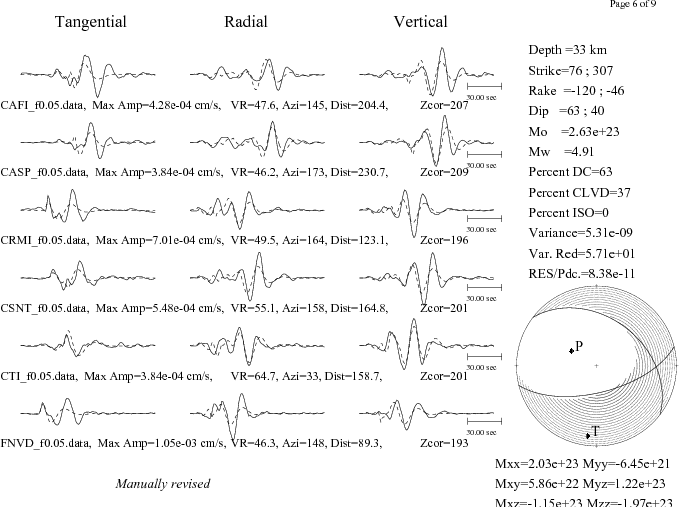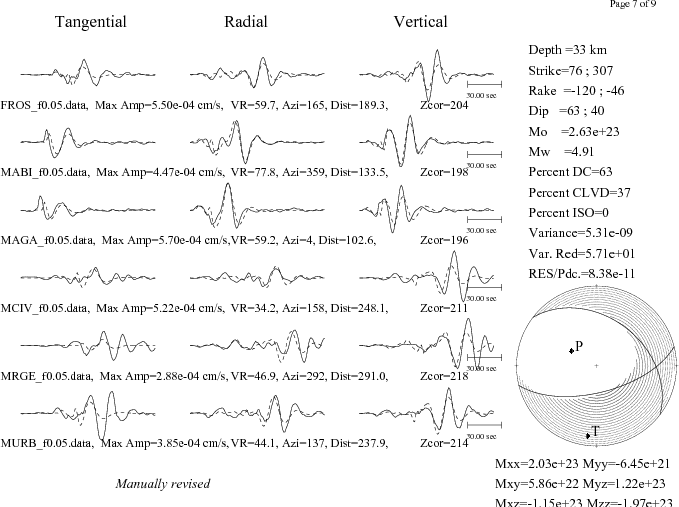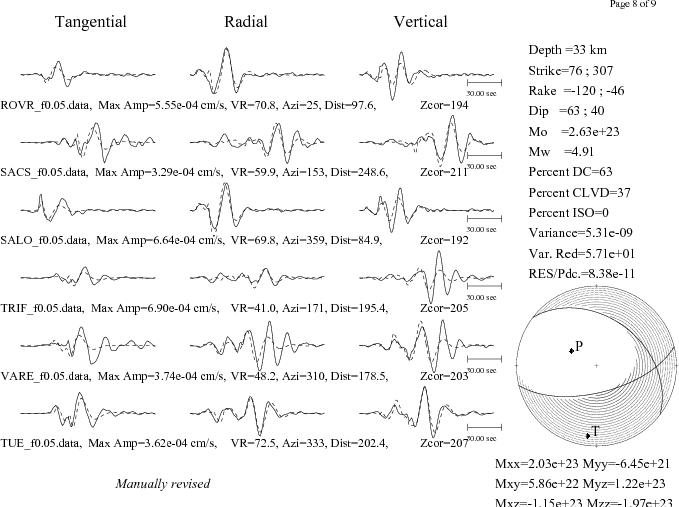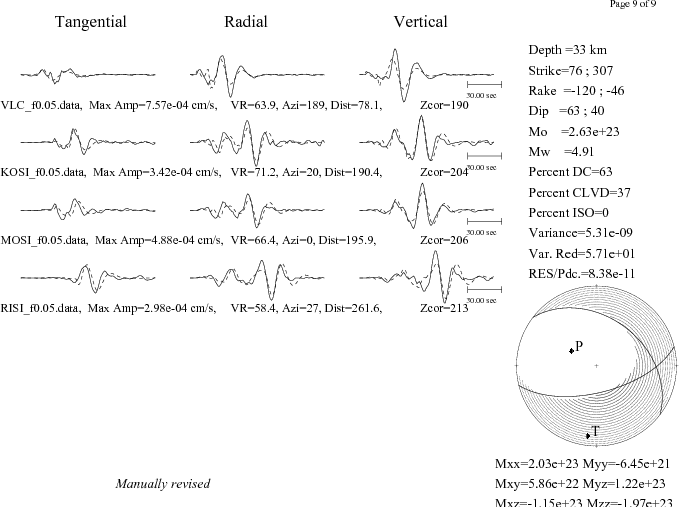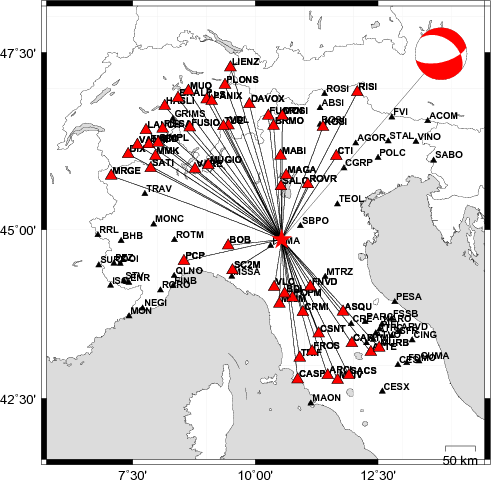Location
2012/01/25 08:06:36 44.854 10.538 33.2 4.9 Italy
Arrival Times (from USGS)
Arrival time list
Felt Map
USGS Felt map for this earthquake
USGS Felt reports page for
Focal Mechanism
SLU Moment Tensor Solution
ENS 2012/01/25 08:06:36:0 44.85 10.54 33.2 4.9 Italy
Stations used:
GU.MAIM GU.PCP GU.POPM GU.SC2M IV.ASQU IV.BOB IV.CAFI
IV.CRE IV.CRMI IV.CSNT IV.FNVD IV.FROS IV.MABI IV.MAGA
IV.MSSA IV.MTRZ IV.PARC IV.QLNO IV.ROVR IV.SALO IV.TEOL
IV.VARE IV.ZCCA MN.TUE MN.VLC NI.CGRP
Filtering commands used:
hp c 0.02 n 3
lp c 0.05 n 3
Best Fitting Double Couple
Mo = 2.07e+23 dyne-cm
Mw = 4.81
Z = 26 km
Plane Strike Dip Rake
NP1 82 80 -118
NP2 335 30 -20
Principal Axes:
Axis Value Plunge Azimuth
T 2.07e+23 29 195
N 0.00e+00 28 88
P -2.07e+23 47 323
Moment Tensor: (dyne-cm)
Component Value
Mxx 8.53e+22
Mxy 8.58e+22
Mxz -1.67e+23
Myy -2.41e+22
Myz 3.90e+22
Mzz -6.12e+22
##############
-------------#########
-------------------#########
-----------------------#######
--------------------------########
---------- ----------------#######
----------- P -----------------#######
------------ ------------------#######
----------------------------------######
------------------------------------######
------------------------------------#-----
------------------------------######------
#------------------#################------
###################################-----
###################################-----
##################################----
################################----
############ ################---
########## T ###############--
######### ##############--
#####################-
##############
Global CMT Convention Moment Tensor:
R T P
-6.12e+22 -1.67e+23 -3.90e+22
-1.67e+23 8.53e+22 -8.58e+22
-3.90e+22 -8.58e+22 -2.41e+22
Details of the solution is found at
http://www.eas.slu.edu/eqc/eqc_mt/MECH.IT/20120125080636/index.html
|
Preferred Solution
The preferred solution from an analysis of the surface-wave spectral amplitude radiation pattern, waveform inversion and first motion observations is
STK = 335
DIP = 30
RAKE = -20
MW = 4.81
HS = 26.0
The waveform inversion is preferred.
Moment Tensor Comparison
The following compares this source inversion to others
| SLU |
INGVTDMT |
SLU Moment Tensor Solution
ENS 2012/01/25 08:06:36:0 44.85 10.54 33.2 4.9 Italy
Stations used:
GU.MAIM GU.PCP GU.POPM GU.SC2M IV.ASQU IV.BOB IV.CAFI
IV.CRE IV.CRMI IV.CSNT IV.FNVD IV.FROS IV.MABI IV.MAGA
IV.MSSA IV.MTRZ IV.PARC IV.QLNO IV.ROVR IV.SALO IV.TEOL
IV.VARE IV.ZCCA MN.TUE MN.VLC NI.CGRP
Filtering commands used:
hp c 0.02 n 3
lp c 0.05 n 3
Best Fitting Double Couple
Mo = 2.07e+23 dyne-cm
Mw = 4.81
Z = 26 km
Plane Strike Dip Rake
NP1 82 80 -118
NP2 335 30 -20
Principal Axes:
Axis Value Plunge Azimuth
T 2.07e+23 29 195
N 0.00e+00 28 88
P -2.07e+23 47 323
Moment Tensor: (dyne-cm)
Component Value
Mxx 8.53e+22
Mxy 8.58e+22
Mxz -1.67e+23
Myy -2.41e+22
Myz 3.90e+22
Mzz -6.12e+22
##############
-------------#########
-------------------#########
-----------------------#######
--------------------------########
---------- ----------------#######
----------- P -----------------#######
------------ ------------------#######
----------------------------------######
------------------------------------######
------------------------------------#-----
------------------------------######------
#------------------#################------
###################################-----
###################################-----
##################################----
################################----
############ ################---
########## T ###############--
######### ##############--
#####################-
##############
Global CMT Convention Moment Tensor:
R T P
-6.12e+22 -1.67e+23 -3.90e+22
-1.67e+23 8.53e+22 -8.58e+22
-3.90e+22 -8.58e+22 -2.41e+22
Details of the solution is found at
http://www.eas.slu.edu/eqc/eqc_mt/MECH.IT/20120125080636/index.html
|
|
Waveform Inversion
The focal mechanism was determined using broadband seismic waveforms. The location of the event and the
and stations used for the waveform inversion are shown in the next figure.

|
|
Location of broadband stations used for waveform inversion
|
The program wvfgrd96 was used with good traces observed at short distance to determine the focal mechanism, depth and seismic moment. This technique requires a high quality signal and well determined velocity model for the Green functions. To the extent that these are the quality data, this type of mechanism should be preferred over the radiation pattern technique which requires the separate step of defining the pressure and tension quadrants and the correct strike.
The observed and predicted traces are filtered using the following gsac commands:
hp c 0.02 n 3
lp c 0.05 n 3
The results of this grid search from 0.5 to 19 km depth are as follow:
DEPTH STK DIP RAKE MW FIT
WVFGRD96 1.0 95 50 -100 4.51 0.2883
WVFGRD96 2.0 285 40 -85 4.57 0.2982
WVFGRD96 3.0 285 40 -85 4.61 0.2726
WVFGRD96 4.0 340 25 -10 4.61 0.2325
WVFGRD96 5.0 340 20 -10 4.71 0.2685
WVFGRD96 6.0 340 20 -10 4.71 0.3114
WVFGRD96 7.0 340 20 -10 4.71 0.3501
WVFGRD96 8.0 340 25 -10 4.67 0.3827
WVFGRD96 9.0 340 25 -10 4.67 0.4091
WVFGRD96 10.0 340 25 -15 4.68 0.4331
WVFGRD96 11.0 340 25 -15 4.68 0.4534
WVFGRD96 12.0 340 25 -15 4.69 0.4722
WVFGRD96 13.0 340 25 -15 4.69 0.4888
WVFGRD96 14.0 340 30 -15 4.70 0.5031
WVFGRD96 15.0 335 25 -20 4.74 0.5148
WVFGRD96 16.0 335 25 -20 4.75 0.5275
WVFGRD96 17.0 335 25 -20 4.75 0.5384
WVFGRD96 18.0 335 25 -20 4.76 0.5478
WVFGRD96 19.0 335 25 -20 4.77 0.5555
WVFGRD96 20.0 335 25 -20 4.77 0.5615
WVFGRD96 21.0 335 30 -20 4.78 0.5664
WVFGRD96 22.0 330 30 -25 4.79 0.5668
WVFGRD96 23.0 330 30 -25 4.80 0.5688
WVFGRD96 24.0 335 30 -20 4.80 0.5726
WVFGRD96 25.0 335 30 -20 4.81 0.5721
WVFGRD96 26.0 335 30 -20 4.81 0.5730
WVFGRD96 27.0 335 30 -20 4.82 0.5706
WVFGRD96 28.0 340 35 -15 4.82 0.5682
WVFGRD96 29.0 340 35 -15 4.83 0.5682
The best solution is
WVFGRD96 26.0 335 30 -20 4.81 0.5730
The mechanism correspond to the best fit is

|
|
Figure 1. Waveform inversion focal mechanism
|
The best fit as a function of depth is given in the following figure:

|
|
Figure 2. Depth sensitivity for waveform mechanism
|
The comparison of the observed and predicted waveforms is given in the next figure. The red traces are the observed and the blue are the predicted.
Each observed-predicted component is plotted to the same scale and peak amplitudes are indicated by the numbers to the left of each trace. A pair of numbers is given in black at the right of each predicted traces. The upper number it the time shift required for maximum correlation between the observed and predicted traces. This time shift is required because the synthetics are not computed at exactly the same distance as the observed and because the velocity model used in the predictions may not be perfect.
A positive time shift indicates that the prediction is too fast and should be delayed to match the observed trace (shift to the right in this figure). A negative value indicates that the prediction is too slow. The lower number gives the percentage of variance reduction to characterize the individual goodness of fit (100% indicates a perfect fit).
The bandpass filter used in the processing and for the display was
hp c 0.02 n 3
lp c 0.05 n 3

|
|
Figure 3. Waveform comparison for selected depth
|

|
|
Focal mechanism sensitivity at the preferred depth. The red color indicates a very good fit to thewavefroms.
Each solution is plotted as a vector at a given value of strike and dip with the angle of the vector representing the rake angle, measured, with respect to the upward vertical (N) in the figure.
|
A check on the assumed source location is possible by looking at the time shifts between the observed and predicted traces. The time shifts for waveform matching arise for several reasons:
- The origin time and epicentral distance are incorrect
- The velocity model used for the inversion is incorrect
- The velocity model used to define the P-arrival time is not the
same as the velocity model used for the waveform inversion
(assuming that the initial trace alignment is based on the
P arrival time)
Assuming only a mislocation, the time shifts are fit to a functional form:
Time_shift = A + B cos Azimuth + C Sin Azimuth
The time shifts for this inversion lead to the next figure:

The derived shift in origin time and epicentral coordinates are given at the bottom of the figure.
Discussion
Velocity Model
The nnCIA used for the waveform synthetic seismograms and for the surface wave eigenfunctions and dispersion is as follows:
MODEL.01
C.It. A. Di Luzio et al Earth Plan Lettrs 280 (2009) 1-12 Fig 5. 7-8 MODEL/SURF3
ISOTROPIC
KGS
FLAT EARTH
1-D
CONSTANT VELOCITY
LINE08
LINE09
LINE10
LINE11
H(KM) VP(KM/S) VS(KM/S) RHO(GM/CC) QP QS ETAP ETAS FREFP FREFS
1.5000 3.7497 2.1436 2.2753 0.500E-02 0.100E-01 0.00 0.00 1.00 1.00
3.0000 4.9399 2.8210 2.4858 0.500E-02 0.100E-01 0.00 0.00 1.00 1.00
3.0000 6.0129 3.4336 2.7058 0.500E-02 0.100E-01 0.00 0.00 1.00 1.00
7.0000 5.5516 3.1475 2.6093 0.167E-02 0.333E-02 0.00 0.00 1.00 1.00
15.0000 5.8805 3.3583 2.6770 0.167E-02 0.333E-02 0.00 0.00 1.00 1.00
6.0000 7.1059 4.0081 3.0002 0.167E-02 0.333E-02 0.00 0.00 1.00 1.00
8.0000 7.1000 3.9864 3.0120 0.167E-02 0.333E-02 0.00 0.00 1.00 1.00
0.0000 7.9000 4.4036 3.2760 0.167E-02 0.333E-02 0.00 0.00 1.00 1.00
Quality Control
Here we tabulate the reasons for not using certain digital data sets
The following stations did not have a valid response files:
DATE=Fri Feb 17 07:46:16 CST 2012
Last Changed 2012/01/25
